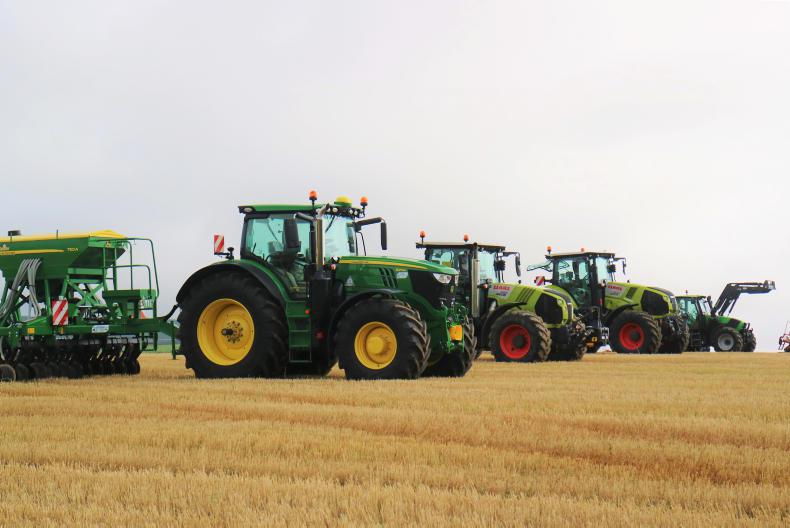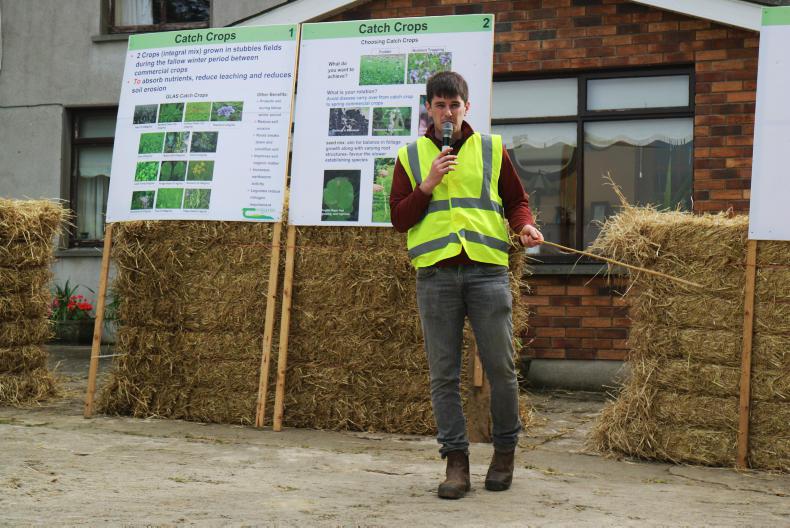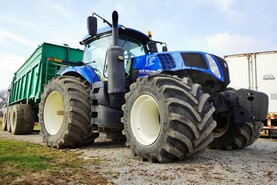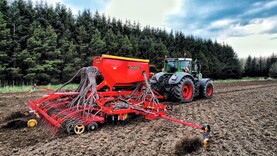The harvest is now complete for many after a somewhat settled couple of weeks in the east and south. Further west and north, however, harvest progress has been much slower and a rather frustrating affair.
Catch crops have grown in popularity in recent years thanks in part to their promotion through environmental schemes, greening requirements and a scarcity of fodder in 2018. However, many growers have come to accept the benefit of establishing a crop to help catch nutrients, provide soil cover for the winter and improve soil heath.

A selection of machinery demonstrating on the day.
Catch crop drilling has been staggered this year due to a broken harvest and a delay in clearing fields of straw. But drilling is still ongoing and at this stage in the year, every day matters. The aim of the game is to get crops drilled as early as possible to allow them to maximise their growth potential. This was one of key messages of a recent Teagasc catch crop and drilling event held on the farm of John Crowley in Ferns, Co Wexford.
Purpose
Catch crops are grown in stubble fields during the fallow period between two commercial crops, ensuring a living crop is in the ground for the majority of the year. They help act as a nutrient absorber, holding these nutrients until they are released through incorporation or through grazing animals.
Catch crops also provide ground cover over the winter, reducing compaction and erosion from rain during the winter months.

Other benefits provided by catch crops depend on the species of crop sown. Deep rooting plants, such as tillage radish, help break down and condition soil. Legume species such as vetch can fix soil nitrogen while buckwheat can scavenge for phosphorus. Both of these species help to make these nutrients available for the following crop.
When crops are incorporated, over time they help build soil organic matter and increase soil microbial and earthworm activity, all of which create a better growing environment for commercial crops.
Catch crop mixes should consist of a balance in foliage growth along with varying root structures and depths. However, care should be given to species selection in the context for your rotation. Growers need to ensure to avoid disease or pest carryover from catch crop to commercial crops such as clubroot in brassicas, sclerotinia in legumes and aphid carryover in beans.
Establishment trials
To draw comparisons between the various cover crop establishment methods, Eoin Lyons was on hand to explain Teagasc’s cover crop establishment trail.

Eoin Lyons of Teagasc oversees the joint malting barley programme.
The trial consists of mustard sown using four different establishment techniques in early August. The crops were sown after craft winter malting barley.
The four different establishment systems used were disc drilling, direct drilling, broadcasting on to disced ground and broadcasting directly on to stubble.

The trial was in the early stages when we walked the fields, but a reasonable difference could be seen between the plots.
The crops sown with a disc drill appeared to be the strongest on the day, with good establishment levels. Based on contractor charges, this system cost around €20-€25/ac.
Crops in the direct-drilled plot were somewhat behind the disc-drilled plots, but establishment was still good. This cost substantially higher, at around €34-€40/ac due to the limited availability of contractors with direct drills in the area.
Crops broadcast on to disced ground and rolled afterwards established reasonably well but lacked uniformity. This method cost around €15/ac.

Finally, crops broadcast directly on to the stubble ground and rolled had poor establishment but cost around €5/ac.
The crops from each establishment method will be monitored throughout the season. The second phase of the trial will attempt to quantify the amount of nitrogen those catch crops will provide for the subsequent spring malting barley crop. This will help determine the impact that these catch crops have on the yield and protein levels.
Value of forage crops
The potential for catch crops to be sold as forage for livestock over the winter period was also discussed on the day. Many growers planted forage crops such as fodder rape, leafy turnip and hybrid ryegrass last year in response to fodder shortages.
There appears to be little chance of a shortage in fodder this year, but forage crops may still be a good option in some circumstances.

Good crowds attended the open day.
Lighter animals are most suited to creep-grazing forage crops due to their ease on ground. This system only works where a tillage field is well fenced and has some access to water. Crops may be zero-grazed or baled, but low dry matter values generally make this difficult.
The question on many growers’ minds is how much are forage crops worth for grazing this year. The Irish Farmers Journal spoke to James Doran, drystock adviser with Teagasc, about marketing forage crops this season.
He calculated that a fodder crop which yields around 4t of dry matter/ha is worth around €125/ac to graze. This is based on the equivalent unit of energy value for silage which he calculated to be around 11c/unit of energy.
However, this value is based on 70% utilisation of the forage crops in good conditions. Utilisation is driven by the weather and grazing conditions and could range anywhere from 10% to 70% depending on the season.
This is one of the biggest risks to farmers when either growing or renting and grazing a forage crop as winter weather is unpredictable.

The August-sown mustard which was established using a disc drill.
Where utilisation is 30%, the crop is then worth around €50/ac on an energy basis. But if severe poaching is incurred when grazing, then the damage to soil is likely to exceed €50/ac in value.
When negotiating the agreement, bear in mind that animals need some source of fibre (at least 30% of diet) as well as the forage crop, so there may be an opportunity to market straw as part of the package.
It is worth reminding readers that the deadline for establishing catch crops for GLAS is 15 September. Grazing of these crops is permitted after 1 December. Remember that ploughing is not permitted to establish these crops. Instead, use a disc drill, direct drill or use light cultivation and broadcast the seed. Use a mix of at least two species from the recommended GLAS list.
Read more
Waterproof wheat developed using gene editing
Germination the main rejection reason at Boortmalt
Growers won’t be penalised for failing to deliver forward-sold malting barley
The harvest is now complete for many after a somewhat settled couple of weeks in the east and south. Further west and north, however, harvest progress has been much slower and a rather frustrating affair.
Catch crops have grown in popularity in recent years thanks in part to their promotion through environmental schemes, greening requirements and a scarcity of fodder in 2018. However, many growers have come to accept the benefit of establishing a crop to help catch nutrients, provide soil cover for the winter and improve soil heath.

A selection of machinery demonstrating on the day.
Catch crop drilling has been staggered this year due to a broken harvest and a delay in clearing fields of straw. But drilling is still ongoing and at this stage in the year, every day matters. The aim of the game is to get crops drilled as early as possible to allow them to maximise their growth potential. This was one of key messages of a recent Teagasc catch crop and drilling event held on the farm of John Crowley in Ferns, Co Wexford.
Purpose
Catch crops are grown in stubble fields during the fallow period between two commercial crops, ensuring a living crop is in the ground for the majority of the year. They help act as a nutrient absorber, holding these nutrients until they are released through incorporation or through grazing animals.
Catch crops also provide ground cover over the winter, reducing compaction and erosion from rain during the winter months.

Other benefits provided by catch crops depend on the species of crop sown. Deep rooting plants, such as tillage radish, help break down and condition soil. Legume species such as vetch can fix soil nitrogen while buckwheat can scavenge for phosphorus. Both of these species help to make these nutrients available for the following crop.
When crops are incorporated, over time they help build soil organic matter and increase soil microbial and earthworm activity, all of which create a better growing environment for commercial crops.
Catch crop mixes should consist of a balance in foliage growth along with varying root structures and depths. However, care should be given to species selection in the context for your rotation. Growers need to ensure to avoid disease or pest carryover from catch crop to commercial crops such as clubroot in brassicas, sclerotinia in legumes and aphid carryover in beans.
Establishment trials
To draw comparisons between the various cover crop establishment methods, Eoin Lyons was on hand to explain Teagasc’s cover crop establishment trail.

Eoin Lyons of Teagasc oversees the joint malting barley programme.
The trial consists of mustard sown using four different establishment techniques in early August. The crops were sown after craft winter malting barley.
The four different establishment systems used were disc drilling, direct drilling, broadcasting on to disced ground and broadcasting directly on to stubble.

The trial was in the early stages when we walked the fields, but a reasonable difference could be seen between the plots.
The crops sown with a disc drill appeared to be the strongest on the day, with good establishment levels. Based on contractor charges, this system cost around €20-€25/ac.
Crops in the direct-drilled plot were somewhat behind the disc-drilled plots, but establishment was still good. This cost substantially higher, at around €34-€40/ac due to the limited availability of contractors with direct drills in the area.
Crops broadcast on to disced ground and rolled afterwards established reasonably well but lacked uniformity. This method cost around €15/ac.

Finally, crops broadcast directly on to the stubble ground and rolled had poor establishment but cost around €5/ac.
The crops from each establishment method will be monitored throughout the season. The second phase of the trial will attempt to quantify the amount of nitrogen those catch crops will provide for the subsequent spring malting barley crop. This will help determine the impact that these catch crops have on the yield and protein levels.
Value of forage crops
The potential for catch crops to be sold as forage for livestock over the winter period was also discussed on the day. Many growers planted forage crops such as fodder rape, leafy turnip and hybrid ryegrass last year in response to fodder shortages.
There appears to be little chance of a shortage in fodder this year, but forage crops may still be a good option in some circumstances.

Good crowds attended the open day.
Lighter animals are most suited to creep-grazing forage crops due to their ease on ground. This system only works where a tillage field is well fenced and has some access to water. Crops may be zero-grazed or baled, but low dry matter values generally make this difficult.
The question on many growers’ minds is how much are forage crops worth for grazing this year. The Irish Farmers Journal spoke to James Doran, drystock adviser with Teagasc, about marketing forage crops this season.
He calculated that a fodder crop which yields around 4t of dry matter/ha is worth around €125/ac to graze. This is based on the equivalent unit of energy value for silage which he calculated to be around 11c/unit of energy.
However, this value is based on 70% utilisation of the forage crops in good conditions. Utilisation is driven by the weather and grazing conditions and could range anywhere from 10% to 70% depending on the season.
This is one of the biggest risks to farmers when either growing or renting and grazing a forage crop as winter weather is unpredictable.

The August-sown mustard which was established using a disc drill.
Where utilisation is 30%, the crop is then worth around €50/ac on an energy basis. But if severe poaching is incurred when grazing, then the damage to soil is likely to exceed €50/ac in value.
When negotiating the agreement, bear in mind that animals need some source of fibre (at least 30% of diet) as well as the forage crop, so there may be an opportunity to market straw as part of the package.
It is worth reminding readers that the deadline for establishing catch crops for GLAS is 15 September. Grazing of these crops is permitted after 1 December. Remember that ploughing is not permitted to establish these crops. Instead, use a disc drill, direct drill or use light cultivation and broadcast the seed. Use a mix of at least two species from the recommended GLAS list.
Read more
Waterproof wheat developed using gene editing
Germination the main rejection reason at Boortmalt
Growers won’t be penalised for failing to deliver forward-sold malting barley













 This is a subscriber-only article
This is a subscriber-only article










SHARING OPTIONS: